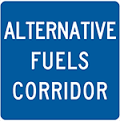Oklahoma interstate motorists will begin to see new signage soon as part of the state’s effort to improve alternative fueling infrastructure, according to a press release issued Monday by the Oklahoma Department of Transportation.
On November 6, OK Energy Today reported the U.S. Department of Transportation’s Federal Highway Administration is designating 48 electric vehicle charging corridors along 25,000 miles of interstate highways.
The FHWA designated I-35, I-40 and I-44 in Oklahoma as alternative fuel corridors, a special designation aimed at improving the mobility of passenger and commercial vehicles that run on alternative fuels. This new designation means special highway signage indicating the nearest alternative fueling station will eventually be placed along these highways by ODOT, according to the press release.
“Oklahoma’s interstates are now part of a national network of highways with easy access to alternative fueling stations,” said Mike Patterson, ODOT’s Executive Director. “The federal designation and placement of signs on our highways will improve travel for drivers and commercial fleets using CNG and electric vehicles.”
ODOT partnered with the Association of Central Oklahoma Governments and the Indian Nations Council of Governments to nominate several Oklahoma highways as alternative fuel corridors. The FHWA approved I-35, I-40 and I-44 as signage ready natural gas fuel corridors and planned electric vehicle charging corridors.
Oklahoma is the only state in the nation with all of its interstate system designated as signage ready for CNG and is now linked to a national network of alternative fuel corridors via highway connections with Texas and Missouri.
“We are excited about this designation from the Federal Highway Administration as it shows the progress of the state’s commitment to an all the above energy strategy which includes transportation,” said Michael Teague, Oklahoma’s Secretary of Energy and Environment. “Alternative fueled vehicles, such as natural gas and electric vehicles, are a key piece of the Oklahoma First Energy Plan to utilize domestic fuels that are clean, efficient, and affordable products of the state. As more Oklahomans make the switch to natural gas or electric vehicles, they know that we have the infrastructure to support them.”
Oklahoma leads the nation in CNG fueling stations per capita, with at least one natural gas fueling station on every 100 miles of interstate highway in the state. Most stations can accommodate both passenger and commercial vehicle fueling.
While Oklahoma’s electric vehicle charging network is less developed, a diverse group of EV stakeholders including convenience stores, electric utilities, auto dealerships and local governments is working together to identify and construct strategic locations for EV superchargers that will ensure border-to-border charging within Oklahoma and connections to adjacent states.
On November 2, OK Energy Today reported that OG&E and OnCue partnered to establish a new EV supercharging station at the convenience store’s Czech Hall Road location in Yukon.






